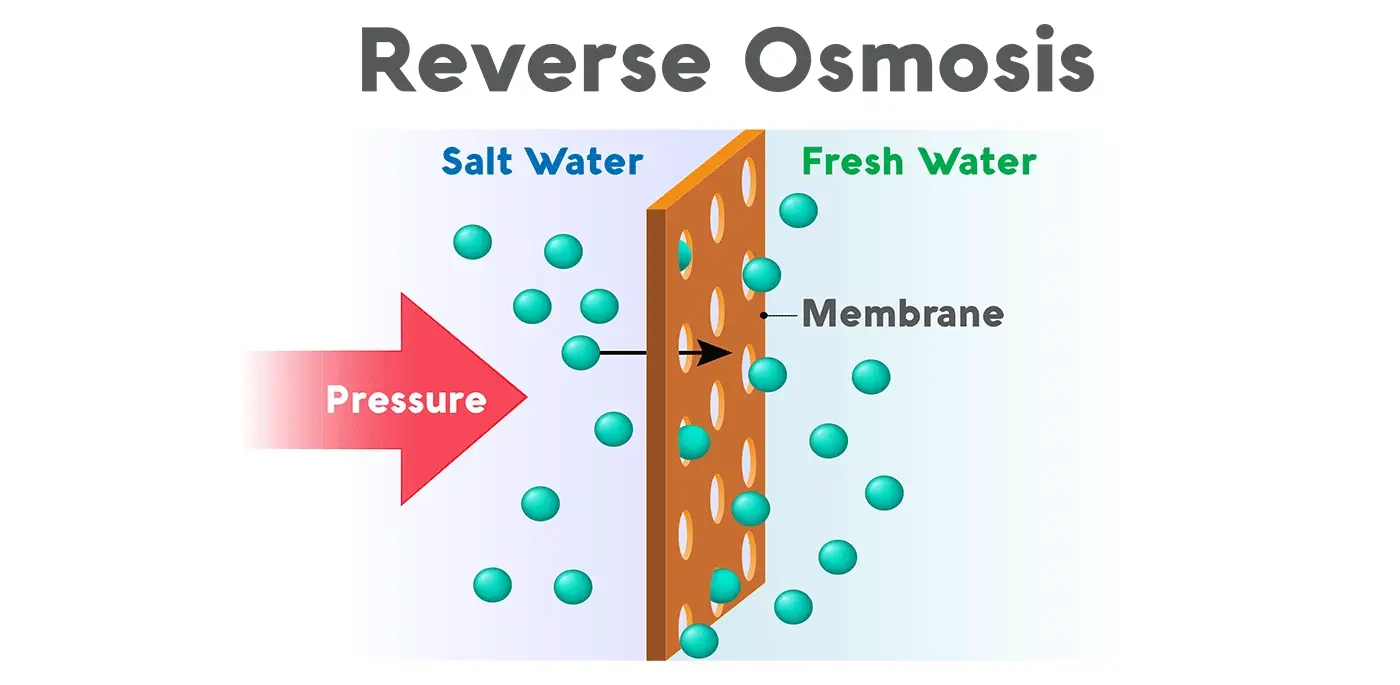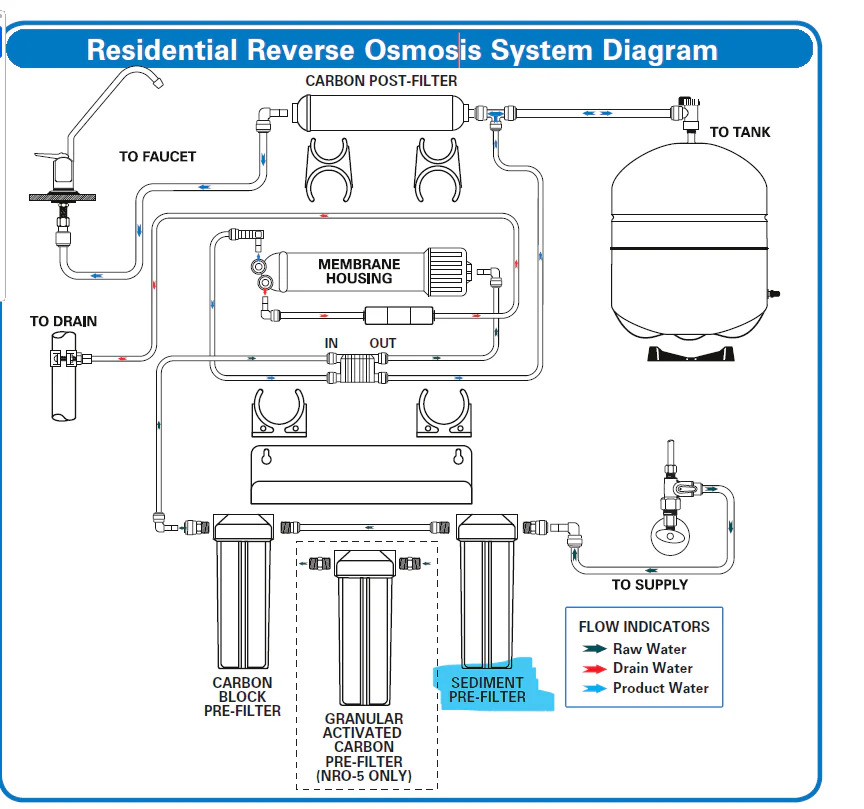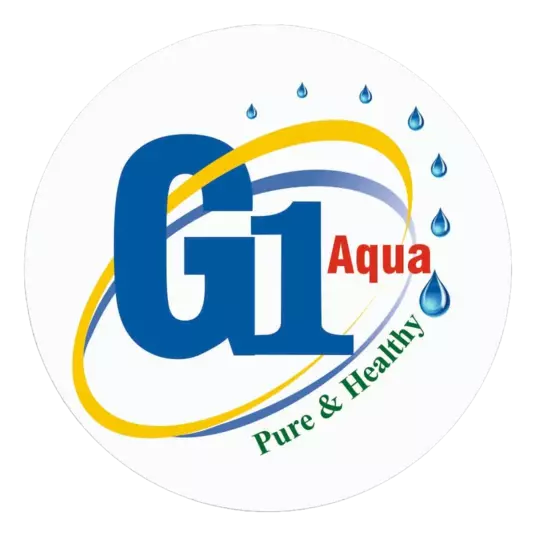Reverse osmosis is a multi-step water purification process that eliminates contaminants from unfiltered water, or feed water, by pushing it through a semipermeable membrane under pressure. Home reverse osmosis systems typically use at least three stages of treatment to significantly reduce the presence of almost all types of contaminants. In the final stage, water moves from the membrane's more concentrated side (with more contaminants) to the less concentrated side (with fewer contaminants), resulting in clean drinking water. This purified water is known as permeate, while the leftover concentrated water is referred to as waste or brine.
What are the benefits of reverse osmosis ?
- Exceptional cleanliness : RO systems remove up to 99% of dissolved salts, particles, colloids, organics, bacteria, and pathogens from water. This greatly reduces harmful contaminants and associated risks.
- Improved taste : By eliminating impurities like chlorine and sediments, RO water tastes cleaner than tap water. However, the removal of minerals can affect taste, so using a system that adds minerals back can enhance the drinking experience.
- Cost-efficiency : An RO system can save money over time compared to buying bottled water, offering a reliable and affordable source of clean water.
- Health benefits : RO water reduces the risk of consuming harmful impurities, supporting better overall health.
- Sustainability : Drinking RO water decreases reliance on plastic bottles, contributing to environmental conservation by reducing plastic waste and pollution.
- Versatility : RO systems are suitable for both home and commercial use, ensuring access to clean water for drinking, cooking, and other needs.
How does reverse osmosis work ?
Reverse osmosis operates using a semipermeable membrane with extremely fine pores designed to filter out contaminants while allowing water molecules to pass through. In the natural process of osmosis, water tends to move across a membrane from an area of lower concentration to one of higher concentration, aiming to balance the concentrations on both sides. However, reverse osmosis works in the opposite manner. By applying pressure to the water, the system forces it to move from the more concentrated side (where contaminants are present) to the less concentrated side, effectively blocking impurities from passing through the membrane.
For example, when reverse osmosis is used on saltwater, the pressure forces the water through the membrane while leaving the salt and other dissolved solids behind. This results in purified water on the other side of the membrane, while the contaminants remain in the concentrated solution. This process ensures that only clean, safe water emerges, free from the impurities that were originally present in the feed water.

How does a reverse osmosis system work ?
A reverse osmosis system removes sediment and chlorine from water with a prefilter before it forces water through a semipermeable membrane to remove dissolved solids. After water exits the RO membrane, it passes through a postfilter to polish the drinking water before it enters a dedicated faucet. Reverse osmosis systems have various stages depending on their number of prefilters and postfilters.
Stages of RO systems
The RO membrane is the focal point of a reverse osmosis system, but an RO system also includes other types of filtration. RO systems are made up of 3, 4, or 5 stages of filtration.
Every reverse osmosis water system contains a sediment filter and a carbon filter in addition to the RO membrane. The filters are called either prefilters or postfilters depending on whether water passes through them before or after it passes through the membrane.
- Sediment filter: This filter eliminates particles such as dirt, dust, and rust.
- Carbon filter: This filter removes chlorine and other volatile organic compounds that can affect the taste and odor.
- RO membrane: This filter eliminates contaminants like sodium, chloride, and lead.
Each type of system contains one or more of the following filters:
- When water initially enters a reverse osmosis (RO) system, it undergoes prefiltration, which typically involves a carbon filter and a sediment filter. These filters remove sediment and chlorine that could clog or damage the RO membrane.
- The water then passes through the RO membrane, where even microscopic particles are filtered out.
- After this stage, the water is directed to a storage tank, where it is held until needed. The RO system continues filtering water until the tank is full, at which point it shuts off.
- When you turn on your drinking water faucet, the water is drawn from the storage tank and passes through a final postfilter. This last filter polishes the water to ensure it's clean and ready for consumption.

Why do you need an RO storage tank ?
RO systems require a storage tank to collect and store purified water. The tank holds a certain amount of water, typically 2-4 gallons, and is connected to the RO system's water line. When you turn on your faucet, water is drawn from the storage tank and passes through the final postfilter before reaching your glass. This setup ensures that you have clean water available at all times, even when the RO system is not actively filtering water.
What does RO remove ?
Reverse osmosis removes chlorine, salt, PFAS, and dissolved solids like arsenic and fluoride through the RO membrane. RO systems also include sediment and carbon filtration for a broad spectrum of reduction. The carbon filters in an RO system remove chlorine, bad taste, and foul odors, and the sediment filter removes dirt and debris.
- Fluoride
- Salt
- Sediment
- Chlorine
- Arsenic
- VOCs
- PFAS
- Microplastics
- Herbicides and pesticides
- Heavy metals
- Many other contaminants
Reverse osmosis systems do not remove some bacteria and viruses. If your water comes from a city treatment plant, then it should already be microbiologically safe. Reverse osmosis may remove some bacteria, but bacteria could grow on the membrane and potentially enter your water supply. To remove living organisms and viruses, we recommend UV disinfection.
What pretreatment does a reverse osmosis system need ?
Pretreatment is crucial for extending the life of a reverse osmosis membrane, especially when dealing with poor water quality. As water flows through an RO membrane, minerals, bacteria, chemicals, or other substances can either absorb onto or form deposits on the membrane. This buildup of contaminants is known as membrane fouling, while inorganic deposits are referred to as membrane scaling. To prevent these issues, it is important to remove contaminants before they can damage the RO membrane. Different types of contaminants require specific pretreatment methods, so understanding the composition of your water is essential for selecting the right pretreatment system. For instance, well water typically requires more extensive prefiltration compared to city-treated water.
